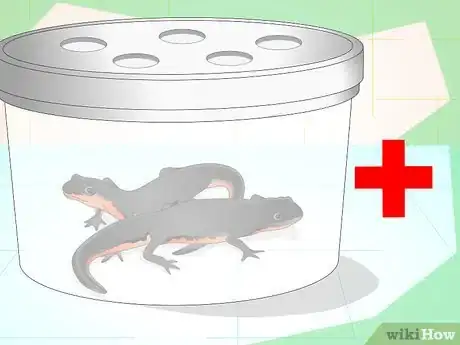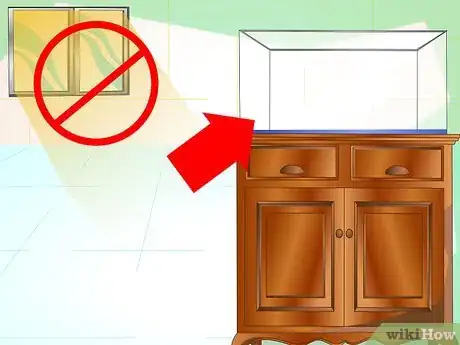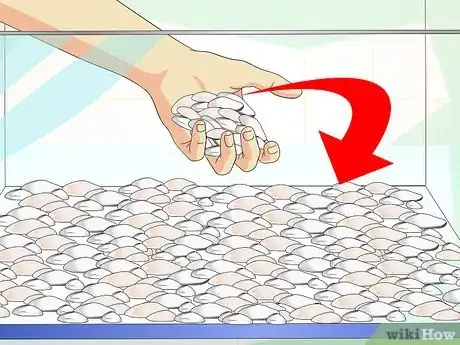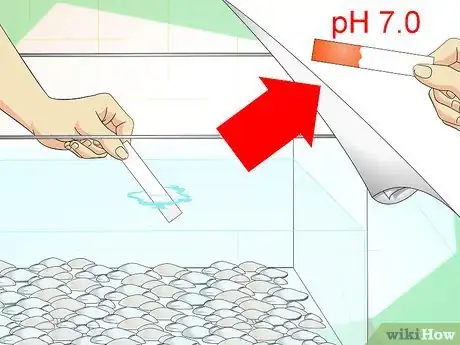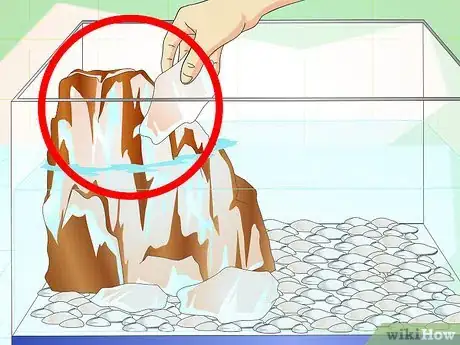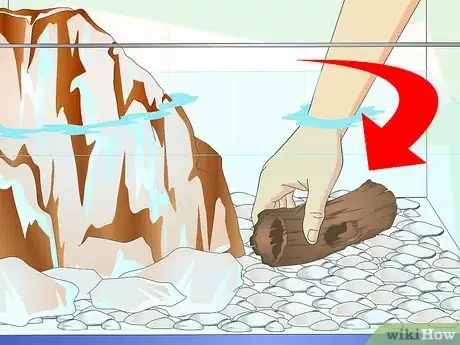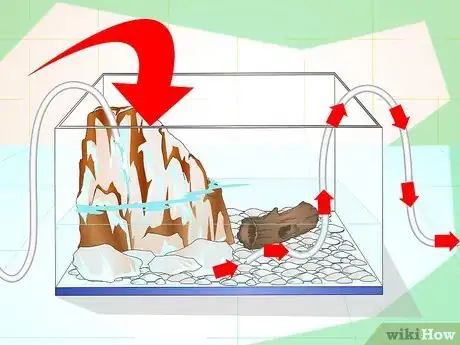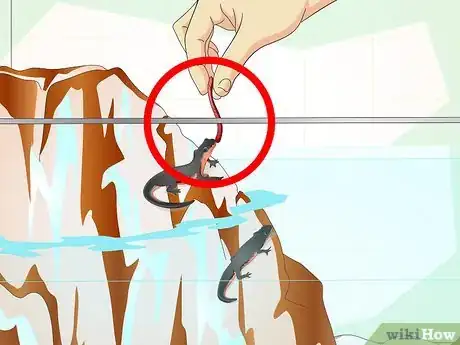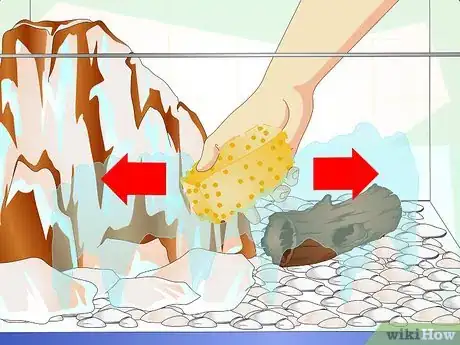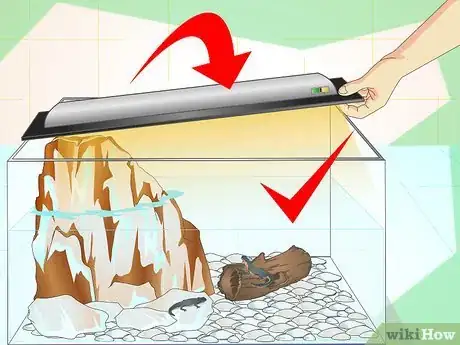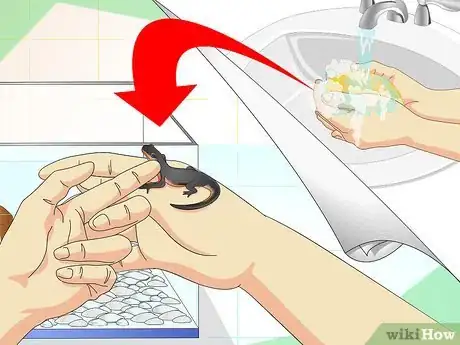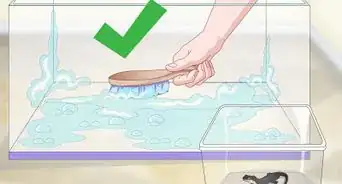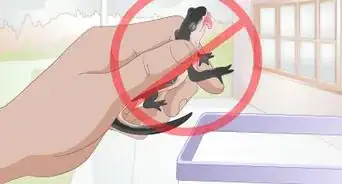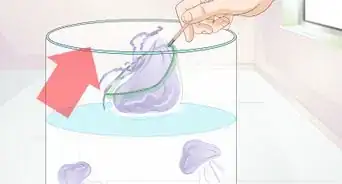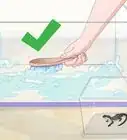X
This article was co-authored by Pippa Elliott, MRCVS. Dr. Elliott, BVMS, MRCVS is a veterinarian with over 30 years of experience in veterinary surgery and companion animal practice. She graduated from the University of Glasgow in 1987 with a degree in veterinary medicine and surgery. She has worked at the same animal clinic in her hometown for over 20 years.
This article has been viewed 50,759 times.
Fire-bellied newts are small amphibians that make great pets and are a wise choice for first-time amphibian owners. Before you get a newt to keep as a pet, educate yourself on their lifestyle and habits and prepare an appropriate habitat to ensure that your newt will live a long and happy life.
Steps
Part 1
Part 1 of 3:
Planning Your Tank
-
1Learn about newts. The type of tank that any reptile or amphibian pet needs depends on several factors that vary by species, including:
- The size of an adult. An adult fire-bellied newt is approximately 4-6 inches long; sometimes pet stores carry juveniles as small as two inches long.[1]
- Its habitat in the wild. Fire-bellied newts originate in Japan, where they are semi-aquatic and spend most of their time in clear, cool bodies of water like lakes, ponds, and streams.[2] This means that pet newts need a home that has water to swim in but also some areas of land; a good rule of thumb is to divide its home with 70% being water and 30% dry land.[3]
- Its habits. Newts are amphibians, so they go through metamorphosis from a tadpole, to larva, to fully developed adult. They spend the first part of their life in water, and as adults spend time on land and in the water. Older fire-belly newts are more aquatic and are generally easier to keep as pets.[4] They can live up to thirty years with excellent care; most live to be about fifteen.[5]
- Its diet. Newts in the wild are carnivorous and like a diet of insects, but you can also feed them dried reptile or amphibian food such as Reptomin Floating Food Sticks.[6] While it's fine to feed them primarily dried food, they need a varied diet including live food such as bloodworms, blackworms, guppies, and crickets; this keeps them active and alert since they have to "hunt," and also helps to ensure they get the proper nutrition. Before you purchase newts, be sure that you have a local store or source to regularly purchase these insects. You must also be sure you'll be comfortable keeping such food available for the newts and feeding live food to them.[7]
-
2Decide how many newts you want. Salamanders are not social nor are they solitary; that means they really don't care either way if they live alone or with others. However, you must only put fire-bellied newts with other newts of the same species and no other types of animals or creatures.[8]
- Fire-bellied newts secrete a toxin from their skin that can be harmful to other species and other types of animals, so it is important to keep only newts of one species in your aquarium.[9]
- Be aware that Japanese and Chinese fire-bellied newts are actually two separate species and they should not be kept together. They are hard to tell apart unless you have seen both types, but Chinese newts are a bit smaller, smoother, and have slightly rounder tail tips than Japanese newts.[10] If in doubt, buy your newts from the same tank at the same store, so that you know they are the same species.
Advertisement -
3Plan where you will keep the tank. You will need a 10 or 20 gallon tank, depending on how many newts you plan to have. One 10 gallon tank can house from one to four newts; for five to ten newts, go with the 20 gallon tank.
- The tank will be heavy and needs to be placed on top of a secure piece of furniture that can hold its weight without risk of tipping or breaking. It also needs to be away from windows and air vents so that heat and cold does not affect your newt.
Advertisement
Part 2
Part 2 of 3:
Preparing and Buying Supplies
-
1Purchase a 10 or 20 gallon aquarium or terrarium. You can purchase these online or in your local pet store or big box store, or shop local garage sales or classified ads to find a used one at a discount.
- Glass or Plexiglas is a good choice so that you can observe your animal. Be sure that the aquarium has a tight fitting lid since newts are notorious for trying to escape their habitats and can climb the glass walls of an aquarium.[11]
-
2Decide if you want to use rocks at the bottom of the tank. It is easier to clean a tank with a smooth bottom, and newts do not need rocks or other substrate in their habitat; but rocks provide an attractive addition to the tank.
- If you use rocks at the bottom of the tank, purchase smooth, rounded stones or gravel and ensure it is large enough that it cannot be ingested. Rough stones will injure the newts' skin.[12]
-
3Test your water quality. Newts have thin skin and chemicals in the water will affect their health and can even kill them. Before filling the tank, check the pH and ammonia of your water with a home test kit (available for purchase online or at your local home or pet store), and use a liquid dechlorinator to prepare the water.
- A pH of 7.0 is ideal for newts, but they will do well in water between 6.5 and 7.5 pH.[13]
- Test your water for ammonia as well (test kits are available in the aquarium section of most large pet stores). Ammonia is lethal to newts.[14]
- Dechlorinating chemicals are available at pet stores in liquid and tablet form. Simply add the recommended amount to the water and let it sit for a few minutes.
- You can also use bottled spring water if you prefer to skip these steps.[15]
-
4Decide what to use for the "land" portion of the aquarium. There are many options and newts can thrive in many different set ups, so it depends mostly on what is available and what you think looks best aesthetically. Remember, the goal is to give the newts dry land in about 30% of their aquarium, which can be made from:
- a rocky slope. You can simply arrange smooth pebbles and rocks, peat, live moss, or sandy soil to come out of the water at a slope so that the newts can climb up to eat.
- floating corkbark, turtle platforms, or live or plastic plants. The "land" does not have to actually be land, as long as it is floating out of the water and the newts can climb onto it.[16]
-
5Provide your newt a place to hide. Newts like to have a place in the water where they can hide and have privacy. You can use something from around your home or purchase something specific for this purpose.
- Pet stores sell all types of hiding places for aquariums, such as tunnels, treasure chests, etc. But you can also use a simple small terracotta pot placed on its side in the bottom of the aquarium. Even a mug you no longer use will work in a pinch.
- You could also use logs, branches, and stones, which can be purchased at a pet store or found in nature. If you use found objects, be sure to sterilize them before putting them in your pet's habitat to ensure there are no insects or parasites present.[17]
Advertisement
Part 3
Part 3 of 3:
Caring for Your Newt
-
1Change the newts' water daily. Newts need about 10 inches of water but since they use the water as their toilet, bacteria will grow quickly unless you change the water frequently. You can change it less often if you only have one or two newts.
- Use a turkey baster or small measuring cup to remove most of the water, and then add in treated, room-temperature water to bring the water level back up to 10 inches.
-
2Feed your newts regularly. Newts only need to be fed 2-3 times a week and most newts will eat 3-4 small insects such as bloodworms, crickets, earthworms, or maggots at each feeding.[18]
- Remove any uneaten bugs or insects after a few hours.
-
3Clean the habitat regularly. Every week or two you should remove the newts (using a fish net or your hands, if you can catch them) to a small holding container with a lid while thoroughly sanitizing the entire habitat.
- The water should be completely refreshed and the inside of the aquarium sanitized, including any additions to the habitat like rocks or plastic plants. Any live plants should be removed while cleaning the enclosure to be replaced when everything is sanitized.[19]
- Be sure that you let the water in the tank come to room temperature before you put the newts back in, since they are sensitive to hot and cold temperatures.
-
4Be safe with lighting. Newts do not require additional heating or lighting, and can become overheated if they are too close to a light source. However, you can use an aquarium light to help you see the newt in its habitat.
- Ensure that you switch off any lights at night.
-
5Be careful with handling your newt. Although most people enjoy handling their salamanders occasionally, newts are fragile and can be injured easily. Try to limit your time holding the newts to once a day for a few minutes.
- Ensure that your own hands are moist when you handle the newts, as this helps to protect its protective mucus covering on its skin.[20]
- Newts also secrete a toxin from their skin, so it is very important that you do not handle them if you have an open cut or wound on your skin as the toxin can be harmful. Be sure that you wash your hands very thoroughly after handling the newt and do not rub your eyes or face when you are holding them, as the toxins can cause temporary blindness.[21]
Advertisement
Things You'll Need
- 10-20 gallon aquarium or terrarium tank with tight lid
- pH testing kit
- ammonia testing kit
- water dechlorinator
- pebbles, floating cork, turtle platform, or live plants to crawl on
- dry and live newt food (amphibian food sticks, bloodworms, crickets, etc.)
- a hiding place (pot, plants, cork, etc.)
- newts
References
- ↑ http://www.reptilesmagazine.com/Care-Sheets/Japanese-Fire-Bellied-Newt-Care-Sheet/
- ↑ http://www.reptilesmagazine.com/Care-Sheets/Japanese-Fire-Bellied-Newt-Care-Sheet/
- ↑ http://www.theamphibian.co.uk/fire-bellied_newt_caresheet.htm
- ↑ http://www.reptilesmagazine.com/Care-Sheets/Japanese-Fire-Bellied-Newt-Care-Sheet/
- ↑ http://www.theamphibian.co.uk/fire-bellied_newt_caresheet.htm
- ↑ http://blogs.thatpetplace.com/thatreptileblog/2012/02/21/newts-as-pets-an-introduction-to-their-care-and-feeding/#.Vlt0_b9qa2E
- ↑ http://www.theamphibian.co.uk/fire-bellied_newt_caresheet.htm
- ↑ http://blogs.thatpetplace.com/thatreptileblog/2012/02/21/newts-as-pets-an-introduction-to-their-care-and-feeding/#.Vlty6L9qa2E
- ↑ http://www.theamphibian.co.uk/fire-bellied_newt_caresheet.htm
- ↑ http://animals.mom.me/can-firebellied-newts-kept-alone-11314.html
- ↑ http://www.theamphibian.co.uk/fire-bellied_newt_caresheet.htm
- ↑ http://blogs.thatpetplace.com/thatreptileblog/2012/02/21/newts-as-pets-an-introduction-to-their-care-and-feeding/#.Vlt0_b9qa2E
- ↑ http://blogs.thatpetplace.com/thatreptileblog/2012/02/21/newts-as-pets-an-introduction-to-their-care-and-feeding/#.Vlt0_b9qa2E
- ↑ http://blogs.thatpetplace.com/thatreptileblog/2012/02/21/newts-as-pets-an-introduction-to-their-care-and-feeding/#.Vlt0_b9qa2E
- ↑ http://www.theamphibian.co.uk/fire-bellied_newt_caresheet.htm
- ↑ http://blogs.thatpetplace.com/thatreptileblog/2012/02/21/newts-as-pets-an-introduction-to-their-care-and-feeding/#.Vlt0_b9qa2E
- ↑ http://www.theamphibian.co.uk/fire-bellied_newt_caresheet.htm
- ↑ http://www.theamphibian.co.uk/fire-bellied_newt_caresheet.htm
- ↑ http://www.theamphibian.co.uk/fire-bellied_newt_caresheet.htm
- ↑ http://blogs.thatpetplace.com/thatreptileblog/2012/02/21/newts-as-pets-an-introduction-to-their-care-and-feeding/#.Vlt0_b9qa2E
- ↑ http://blogs.thatpetplace.com/thatreptileblog/2012/02/21/newts-as-pets-an-introduction-to-their-care-and-feeding/#.Vlt0_b9qa2E
- ↑ http://www.caudata.org/cc/faq/FAQhea.shtml
About This Article
Advertisement

